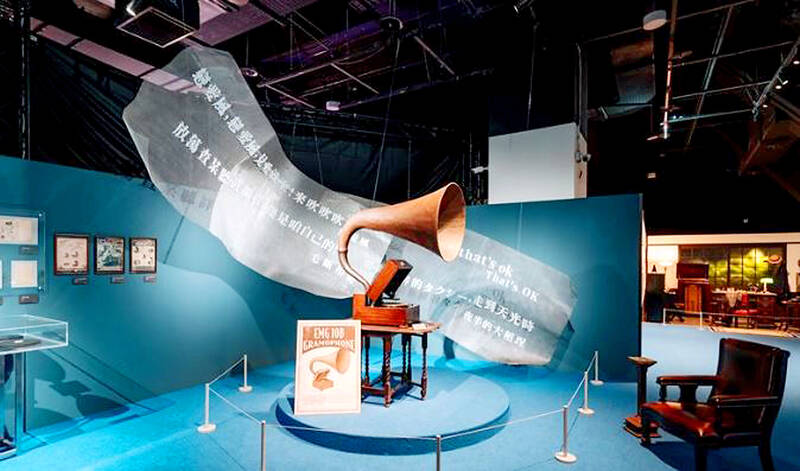Exhibition showcases roots of local pop music under Japanese colonial rule
An exhibition that traces the roots of Taiwan’s pop music opened in Taipei yesterday, featuring three never-released Taiwanese music gems from the 1930s, when Taiwan was still under Japanese colonial rule.
“Modern Era: The Dawn of Pop Music,” a Chinese-English show hosted by the Taipei Music Center, is to run until Aug. 10 on the second floor of the center’s Cultural Cube.
Wang Ying-fen (王櫻芬), the exhibition’s chief consultant, said the show represents the best of private collections of its curators, who generously loaned their precious collectibles to make the show a truly unique experience that people are unlikely to find elsewhere.

Photo courtesy of the Taipei Music Center
Among the exhibits are vintage gramophones and phonographs, as well as colorful metal boxes used to store styli for playing 78rpm shellac records.
Wang, a distinguished professor at National Taiwan University’s Graduate Institute of Musicology, said visitors can listen to three previously unreleased songs.
One is a rare recording by the late Teng Yu-hsien (鄧雨賢), often hailed as “the father of Taiwanese popular songs,” singing his original composition Song By The Sea (臨海曲).
The other two are A Maiden’s Lament (閨女嘆) by Lin Shih-hao (林氏好), known as “Taiwan’s first soprano,” and Wife of a Military Laborer (軍夫之妻) by Chun-chun (純純), a popular female singer in the 1930s.
Visitors can also listen toBrazil Tea Shop (巴西喫茶店), the lyrics of which were written by Chen Jyun-yu (陳君玉) 90 years ago, but had never been set to music until now.
Taipei Music Center chairwoman Kay Huang (黃韻玲) brings the song fully up to date with a stirring melody and a Latin American beat, providing a backdrop on which Golden Melody Award best male Taiwanese singer Henry Hsu (許富凱) laid his vocals.
The show also features renderings of tabloids from the 1930s, printed in Chinese and English, that have love stories behind the hit songs and profiles of some of the top female singers at the time, offering insights into the songs and the entertainment industry in pre-World War II Taiwan.
A long projection screen shows people dressed in kimonos performing dance moves popular at the time.
Back then, each song was choreographed, and records came with “dance scores” that instructed people on how to dance to the music, Wang said.
“[But] I think that we should not just focus on the rhythms, the harmonies and the melodies of the music,” she said. “The bottom line is: We should know our roots, and I hope that this exhibition will remind us all of our roots, no matter how much trends and creations have evolved.”
Tickets are NT$200, NT$150 for students and residents of Neihu (內湖) and Nangang (南港) districts, NT$100 for people aged 65 or older, and free for people with a disability certificate.












